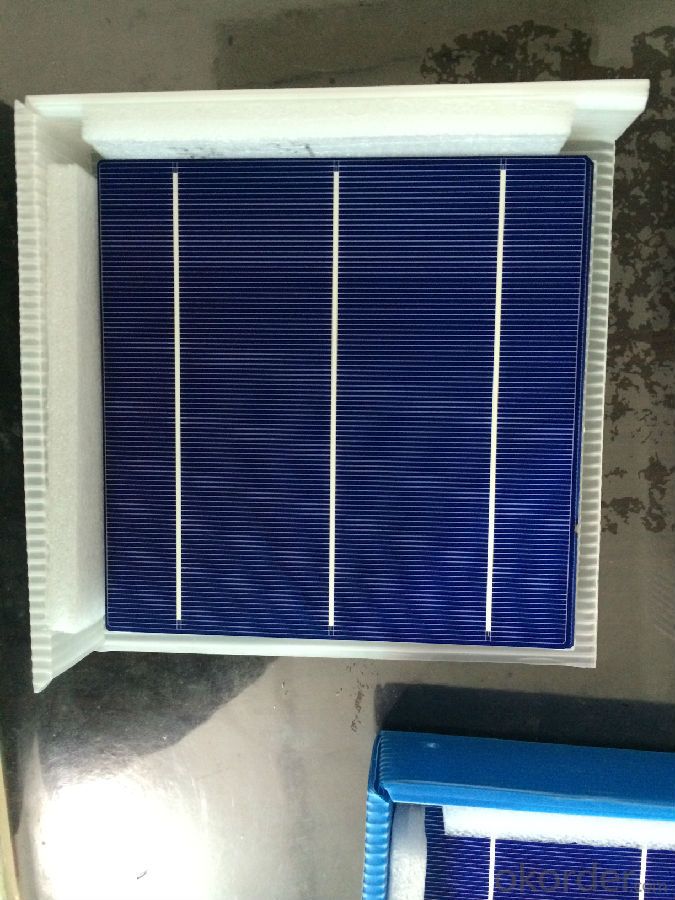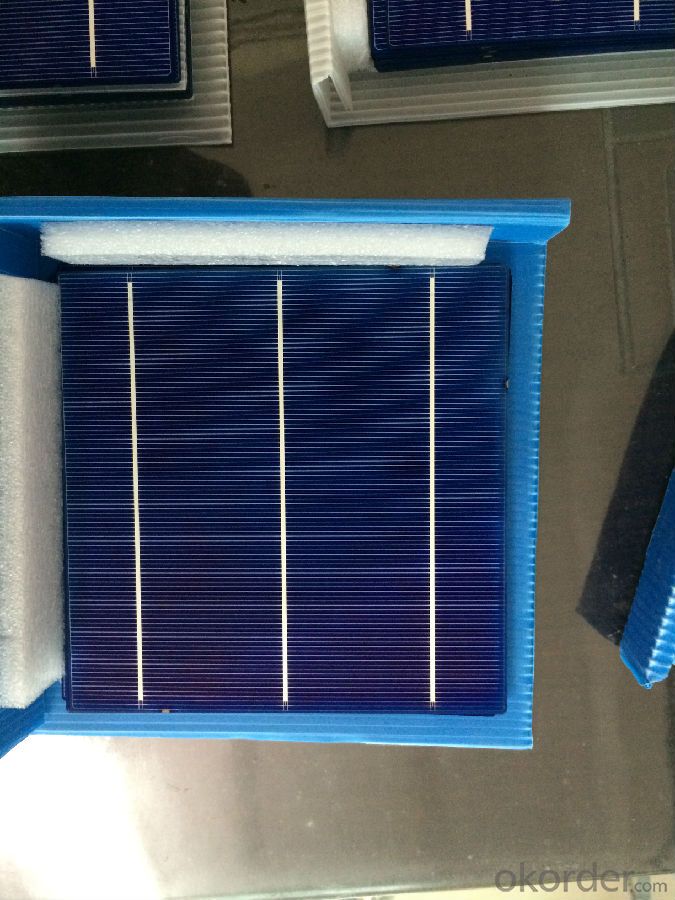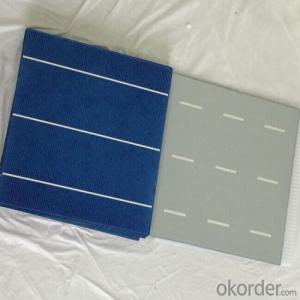Poly Solar Cells 156*156mm B Grade Low Price
- Loading Port:
- Shanghai
- Payment Terms:
- TT or LC
- Min Order Qty:
- 30000 pc
- Supply Capability:
- 1000000 pc/month
OKorder Service Pledge
OKorder Financial Service
You Might Also Like
Product description
Poly Solar Cells 156*156mm B Grade Low Price
A solar cell, or photovoltaic cell, is an electrical device that converts the energy of light directly into electricity by the photovoltaic effect, which is a physical and chemical phenomenon.[1] It is a form of photoelectric cell, defined as a device whose electrical characteristics, such as current, voltage, or resistance, vary when exposed to light. Solar cells are the building blocks of photovoltaic modules, otherwise known as solar panels.
Solar cells are described as being photovoltaic irrespective of whether the source is sunlight or an artificial light. They are used as a photodetector (for example infrared detectors), detecting light or other electromagnetic radiation near the visible range, or measuring light intensity.
In contrast, a solar thermal collector supplies heat by absorbing sunlight, for the purpose of either direct heating or indirect electrical power generation from heat. A "photoelectrolytic cell" (photoelectrochemical cell), on the other hand, refers either to a type of photovoltaic cell (like that developed by Edmond Becquerel and modern dye-sensitized solar cells), or to a device that splits water directly into hydrogen and oxygen using only solar illumination.
Advantage Of Poly Solar Cell 156mm
1: High quality cell, Level A cell (14%—17.5%)
2.Dimensione:156*156mm Diagonal:200mm
3: Qualified certification: TUV,CE certification.
4: Warranty: five years for whole unit
Usage/Application Of Poly Solar Cell 156mm
1.The absorption of light, generating either electron-hole pairs or excitons.
2.The separation of charge carriers of opposite types.
3.The separate extraction of those carriers to an external circuit.
Packaging & Delivery Of Poly Solar Cell 156mm | |
Packaging Detai | Packaging Detail:Export Carton and Pallet or under customer request. |
delivery Detail:10-20days | |




Product Specifician
Electrical Characteristic
Efficiency (%) | Pmpp (W) | Umpp (V) | Impp (A) | Uoc (V) | Isc (A) | FF (%) |
17.25 | 4.197 | 0.524 | 7.992 | 0.62 | 8.458 | 80.03% |
17 | 4.137 | 0.524 | 7.876 | 0.619 | 8.353 | 80.01% |
16.75 | 4.076 | 0.522 | 7.81 | 0.617 | 8.286 | 79.73% |
16.5 | 4.015 | 0.518 | 7.746 | 0.613 | 8.215 | 79.73 |
16.25 | 3.955 | 0.515 | 7.683 | 0.61 | 8.144 | 79.61% |
16 | 3.894 | 0.512 | 7.613 | 0.608 | 8.075 | 79.31% |
15.75 | 3.833 | 0.51 | 7.534 | 0.605 | 8.058 | 78.62% |
15.5 | 3.772 | 0.508 | 7.453 | 0.604 | 8.02 | 77.87% |
15.25 | 3.771 | 0.505 | 7.35 | 0.604 | 9.997 | 76.83% |
15 | 3.65 | 0.503 | 7.271 | 0.604 | 7.989 | 75.64% |
14.5 | 3.529 | 0.499 | 7.067 | 0.604 | 7.988 | 73.14% |
14 | 3.407 | 0.499 | 6.833 | 0.604 | 7.833 | 72.01% |
Intensity Dependence
Intensity [W/m2] | Isc× [mA] | Voc× [mV] |
1000 | 1.00 | 1.000 |
900 | 0.90 | 0.989 |
500 | 0.50 | 0.963 |
300 | 0.30 | 0.939 |
200 | 0.20 | 0.920 |
FAQ
Q:What price for each watt?
A:It depends on the quantity, delivery date and payment terms
Q:What is your warranty system?
A:Our Solar cells performance guarantees for 25 years
Q:How do you pack your products?
A:We have rich experience on how to pack thecells to make sure the safety on shipment when it arrives at the destination.
What is the solar cell
A photoelectric cell designed to convert sunlight into electrical energy,typically consisting of layers or sheets of specially prepared silicon.Electrons, displaced through the photoelectric by the Sun's radiantenergy in one layer, flow across a junction to the other layer, creating avoltage across the layers that can provide power to an external circuit.Solar cells are used as power supplies in calculators, satellites, and otherdevices, and as a primary source of electricity in remote locations.
What is a Solar Cell
A solar cell or photovoltaic cell is a device which generates electricity directly from visible light by means of the photovoltaic effect. In order to generate useful power, it is necessary to connect a number of cells together to form a solar panel, also known as a photovoltaic module. There is more about the the different types of solar cell . The nominal output voltage of a solar panel is usually 12 Volts, and they may be used singly or wired together into an array. The number and size required is determined by the available light and the amount of energy required.
73. What is the tiny little but the most efficient solar cell
While solar power promises a lot and always free compared to other energy, it's only ever going to help satisfy our energy needs if it becomes efficient enough. Fortunately, some solar cell companies has just made the world's most efficient solar cell, which converts a staggering 44.4 percent of incident light into electricity. Fossil fuels may spend less space of our energy.
The cell uses a special lens-based concentrator system, which focuses sunlight onto the cell to help improve the efficiency. Once, the light's focussed, a stack of three photo-absorption layers convert it into electricity. Even then it's no mean feat to squeeze out an efficiency of 44.4 percent, and the process saw Sharp invest a huge amount of time in tuning the device's dimensions to focus the light properly and reduce losses between layers.
While it's impressive, you probably won't see one strapped to the roof of a house any time soon. Devices this exotic are more likely to end up on a spacecraft in the first instance, where efficiency trumps cost every time. That's not to say it won't ever make it to the domestic market—it might just take a little time.
The system of solar cell
The amount of power generated by solar cells is determined by the amount of light falling on them, which is in turn determined by the weather and time of day. In the majority of cases some form of energy storage will be necessary.
In a Grid-connected system, the solar array is connected to the mains. Any surplus power is sold to the electricity company, and power is bought back from them when it is needed.
In a Stand-alone system, however, this is not possible. In this type of system the usual choice for energy storage is the lead-acid battery. The number and type of batteries is dependent on the amount of energy storage needed. Find out more about batteries
- Q:Is silicon-based solar cells and silicon-based thin-film solar cells the same?
- General silicon-based solar cells refer to monocrystalline silicon and polycrystalline silicon solar cells, while silicon-based thin-film solar cells are similar to sunpower producing that type of battery that can be made into curved components.
- Q:Can solar cells be used in remote areas without access to the grid?
- Yes, solar cells can be used in remote areas without access to the grid. Solar cells, also known as photovoltaic cells, generate electricity from sunlight. They can be installed in remote areas to harness the sun's energy and provide power for various applications such as lighting, water pumping, and charging electronic devices. Solar cells are particularly suitable for off-grid locations as they operate independently of the traditional electric grid, making them a reliable and sustainable solution for remote areas.
- Q:What is the maximum efficiency that a solar cell can achieve?
- The maximum efficiency that a solar cell can achieve is known as the Shockley-Queisser limit, which is approximately 33.7%. However, in practical applications, the efficiency of commercial solar cells typically ranges between 15-22%.
- Q:Can solar cells be used in theme parks or amusement parks?
- Yes, solar cells can be used in theme parks or amusement parks. Solar panels can be installed on rooftops, parking structures, or open areas within the park to generate renewable energy. This energy can be used to power rides, lighting, and other facilities, reducing reliance on traditional electricity sources and lowering operating costs. Additionally, incorporating solar technology aligns with the sustainable and eco-friendly image that many theme parks strive to promote.
- Q:Can solar cells be used to power water treatment plants?
- Yes, solar cells can be used to power water treatment plants. Solar energy can be converted into electricity using photovoltaic technology, which can then be utilized to power the various systems and processes involved in water treatment, such as pumps, filters, and disinfection systems. Solar power offers a sustainable and environmentally friendly solution for powering water treatment plants, particularly in areas with abundant sunlight.
- Q:How do solar cells impact greenhouse gas emissions?
- Solar cells have a positive impact on greenhouse gas emissions as they generate electricity from renewable and clean energy sources, such as sunlight. By utilizing solar cells to generate power, we reduce the reliance on fossil fuels, which are major contributors to greenhouse gas emissions. Therefore, solar cells help to mitigate climate change by reducing the overall carbon footprint and promoting a more sustainable and eco-friendly energy system.
- Q:Can solar cells be used to power remote locations?
- Yes, solar cells can be used to power remote locations. Solar cells convert sunlight into electricity, making them an ideal renewable energy source for areas that are not connected to the traditional power grid. They can be installed in remote locations to generate electricity and provide a reliable power supply. Additionally, solar cells are low-maintenance and have a long lifespan, making them a cost-effective solution for powering remote areas.
- Q:How do solar cells perform in high-altitude locations?
- Solar cells perform well in high-altitude locations due to several factors. Firstly, at higher altitudes, there is less atmospheric pollution and dust, resulting in cleaner and clearer sunlight, which enhances the performance of solar cells. Additionally, the thinner atmosphere at high altitudes allows for less scattering and absorption of sunlight, enabling solar cells to receive a higher intensity of solar radiation. This combination of cleaner and more intense sunlight makes solar cells more efficient and productive in high-altitude locations.
- Q:What materials are commonly used to make solar cells?
- The most commonly used materials to make solar cells are silicon, cadmium telluride, and copper indium gallium selenide.
- Q:Where and how can I find more information of Photovoltaic Cells Solar Panels? Can anybody share more about that?
- Photovoltaic cells produce electricity directly from sunlight. Photovoltaic cells are also called PV cells or solar cells. Many PV cells are used in remote locations not connected to the electric grid. Photovoltaic cells comprise the main component in solar panels and are also used to power watches, calculators, solar lights, and lighted road signs.
1. Manufacturer Overview |
|
|---|---|
| Location | |
| Year Established | |
| Annual Output Value | |
| Main Markets | |
| Company Certifications | |
2. Manufacturer Certificates |
|
|---|---|
| a) Certification Name | |
| Range | |
| Reference | |
| Validity Period | |
3. Manufacturer Capability |
|
|---|---|
| a)Trade Capacity | |
| Nearest Port | |
| Export Percentage | |
| No.of Employees in Trade Department | |
| Language Spoken: | |
| b)Factory Information | |
| Factory Size: | |
| No. of Production Lines | |
| Contract Manufacturing | |
| Product Price Range | |
Send your message to us
Poly Solar Cells 156*156mm B Grade Low Price
- Loading Port:
- Shanghai
- Payment Terms:
- TT or LC
- Min Order Qty:
- 30000 pc
- Supply Capability:
- 1000000 pc/month
OKorder Service Pledge
OKorder Financial Service
Similar products
New products
Hot products
Hot Searches
Related keywords





























